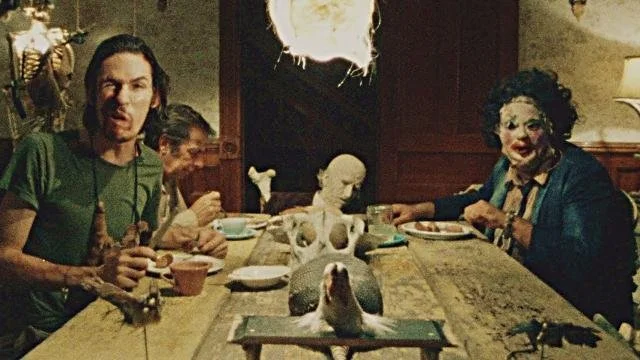#73: The Texas Chain Saw Massacre
Release Date: October 11th, 1973
Format: Theater (The Frida Cinema in Santa Ana, CA)
Written by: Kim Henkel and Tobe Hooper
Directed by: Tobe Hooper
4 Stars
I wish I were more of a horror film historian so I could speak to The Texas Chain Saw Massacre’s impact on the horror genre definitively, but I suppose I’ll do my best. What I do know is that The Texas Chain Saw Massacre is among a small group of horror films that changed the course of the genre, and maybe more so than any others in that group.
When I think of the most artistically and culturally impactful horror movies of the ‘60s and ‘70s era, here’s what comes to mind:
Psycho (1960): Hitchcock shuns the idealism and conservatism of the 1950s and exposes a soft white underbelly of America that was never portrayed in film before Norman Bates arrived on screen. Norman, the polite and seemingly all-American boy next door, is actually a sexually violent psychopath and informs a range of horror killers for decades to come.
Rosemary’s Baby (1968): The first mainstream American movie to take Hitchcockian suspense elements (Psycho most specifically) and incorporate the shifting attitude of the late ‘60s. Rosemary is betrayed by the establishment, her dream of a nuclear family is extinguished, and the film sadly foreshadows the occultist violence that would end the life of director Roman Polanski’s wife, Sharon Tate, at the hands of the Manson family.
The Exorcist (1973): A phenomenon that pushed the boundaries of how horrific a movie could be. A decent portion of the American movie-going public simply wouldn’t see it because they found it so morally objectionable or simply downright too scary. Technically, the sound design, set design, editing, music, practical effects, and lighting were absolutely groundbreaking and provide a blueprint for horror that is still used today.
Halloween (1978): The independent, low-budget masterpiece that arguably created the slasher genre and the “final girl” archetype. Its distinctively simple and iconic score, its simplistic plug-and-play storytelling, and its lack of movie stars ushered in a tidal wave of imitators through the 1980s.
Of course I haven’t yet mentioned The Texas Chain Saw Massacre, released between The Exorcist and Halloween in 1974. I think I can see the linear evolution from one to the other, even though the three movies share little in common aside from their genre.
During this last viewing, I can see director Toby Hooper taking the verisimilitude and harsh technical elements from The Exorcist, and amplifying them even more by using largely inexperienced actors (something John Carpenter does in Halloween). The performances are authentic and give Chainsaw an almost documentary quality.
And like William Friedkin using refrigeration to chill Regan’s bedroom set in The Exorcist to below freezing temperatures so the actors’ breath could be seen on screen, Hooper also challenges his performers by using external elements and shooting locations that seem simply miserable. There isn’t a frame of this movie that doesn’t look disgusting. Suffocating heat, dirt and blood caked onto clothing, roadkill, flies, grime, and grease seem to emanate from the screen. It’s an absolutely disgusting looking movie.
This viewing was the first time I’d seen it with an audience. The Frida was showing it for the film’s 50th anniversary, and I went with D and Bryson (two horror movie buffs that have seen far more horror than I have).
It’s so much fun watching an old movie come alive in front of an appreciative audience. I was amazed at how fun the movie was to watch - gross and horrific, yes, but that’s what we were all there for that night - and the movie even got a few laughs in the right spots that I wasn’t expecting.
Not that it was a light-hearted affair. That final shot of Leatherface wielding his chainsaw in a macabre dance as the Texas sun rises on the horizon made the hair on my neck stand up.
